
Left to right: James Peverill, Dan Patt, Justin Kasznica, Karen Leavitt. Source: Vecna Robotics
BOSTON — At Robotics Summit & Expo 2019 here this month, a panel analyzed the technical, operational, business, and legal aspects of the Robotics-as-a-Service, or RaaS, model for acquiring robots.
“The heart of RaaS is all about flexibility,” said Vecna Robotics CEO Daniel Patt during the panel discussion. “If you could predict the future and know exactly what your needs for work or process would be in 10 years, you’d just design and build the right thing for that. RaaS lowers the cost to grow and the cost to change. It’s about enabling flexibility.”
As manufacturing and warehousing industries grow, robots are becoming a large part of the business plan. Traditionally, robots have been purchased as capital equipment and used to automate a part of the workflow. Recently, companies have been exploring the idea of hiring robot workers similar to the way people are hired: as independent contractors.
The shift that makes this possible is the purchase of not the robot itself, but the service that it provides. Patt called this “work as a service,” while Karen Leavitt, chief marketing officer at Locus Robotics, called it “flexibility as a service.”
From a legal standpoint, Justine Kasznica, a shareholder at Babst Calland Clements & Zomnir, noted that this model aligns well with business goals because it is pricing the service in a way that’s equal to the value provided to the customer.
Materials-handling robots like Vecna’s are providing a solution that changes customer site workflows, essentially amplifying human productivity to increase throughput while maintaining the same footprint of people and space, said Patt. This helps companies overcome the factors that make hiring more difficult and space more constrained when demand is increasing.
“If you construct the model around the work that the robots do, you align your RaaS model around paying for work that’s accomplished and not just for the robot per month; it focuses everybody on what matters,” Patt explained.
Companies are also seeking robots to work in the warehouse fulfillment space to offset the difficulty of hiring seasonal workers. Leavitt noted that Locus’s customers are having difficulty finding workers for a highly seasonal business where the volume around holidays can be up to 15 times higher than usual.
Keeping a large human workforce year-round to accommodate this spike is not feasible, so companies are looking for ways to increase productivity with their current workforce, she said. RaaS has given customers the flexibility to scale up and down with robots and predict workflow requirements more reliably.
Still early days for RaaS
Right now, the RaaS model is in the early stages, and while adopting the model is a growing trend, providers are faced with a few challenges they believe will be overcome as industrial robotics mature, the panelists said. Some larger customers are used to the traditional approach of purchasing capital, and the process to change has been slow. There’s also an emotional barrier for some to sharing robots, which can feel like a member of the team.
On the other hand, many customers adopting the RaaS model have found soaring benefits for their business, according to the Robotics Summit speakers. In RaaS, the provider typically incurs the larger costs associated with robotics including insurance policies and regulatory filings, a value proposition for small to medium-sized companies. Operation managers can purchase robotic services based on actual work that needs to be accomplished, giving more transparency into the value they’re actually paying for.
James Peverill, CEO of GreenSight Agronomics, said he sees seasonality not as a barrier, but as an opportunity for the RaaS model because providers can find co-aligned customers with different peak seasons and ship the solutions from one to another. GreenSight provides technologies for the agriculture industry, where equipment sharing is a common practice among farms that otherwise could not afford it. The RaaS model has been a relatively seamless adoption for many customers, he said.
In the end, robotics is a large investment whether utilizing traditional purchasing models or Robotics-as-a-Service models.
“Manufacturing inherited a lot of processes for predictable work, but manufacturers who are becoming more flexible and desire to scale up and down better will be among the first to embrace RaaS,” emphasized Vecna’s Patt.
Editor’s note: Dan Kara, vice president of robotics at WTWH Media, the parent organization of The Robot Report, moderated the Robotics Summit panel. He will be presenting a webinar on “Robotics Solutions for Small to Midsize Manufacturers” on July 23. This content reposted with permission of Vecna Robotics.

